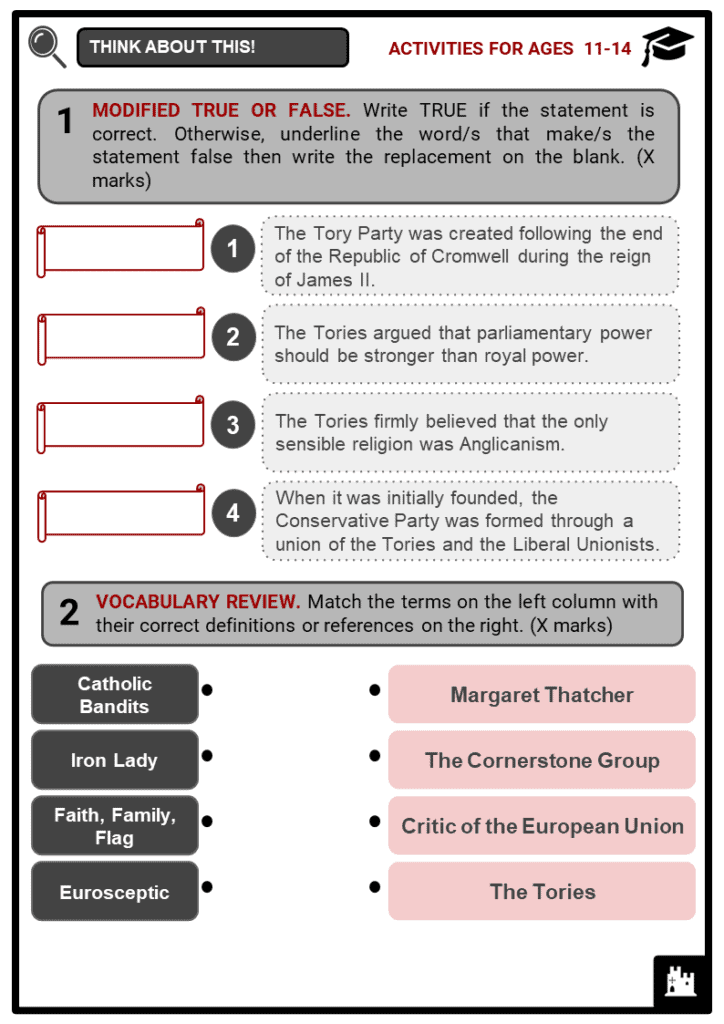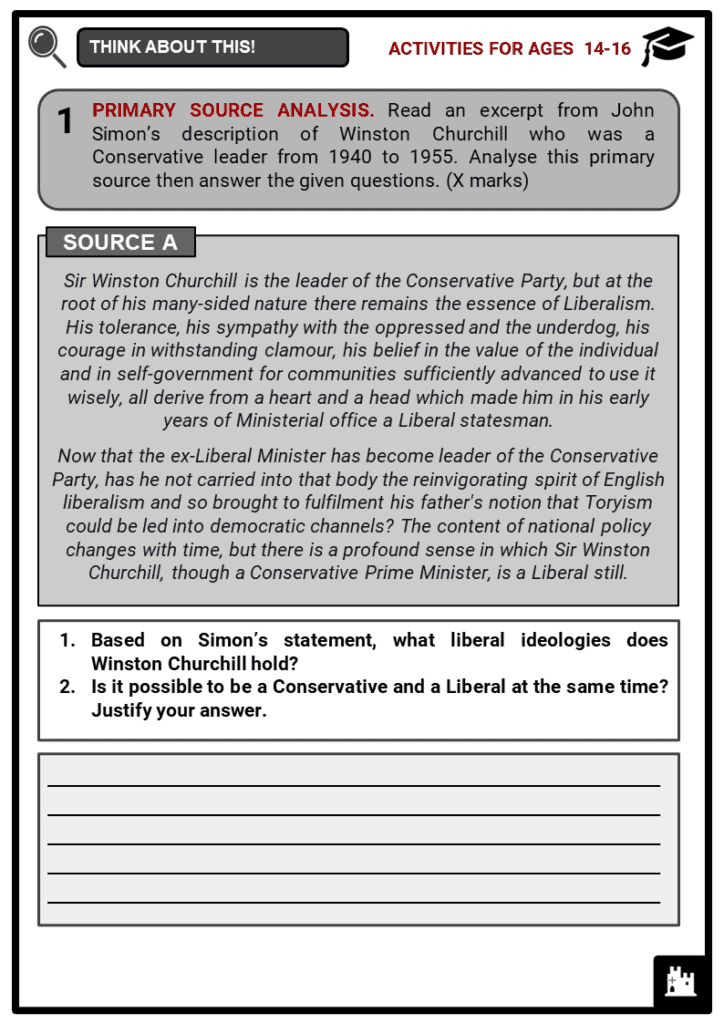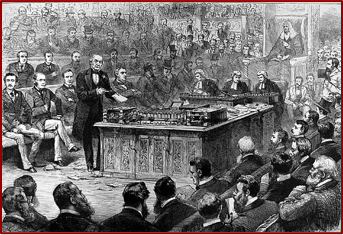Download The Tory Party Worksheets
Do you want to save dozens of hours in time? Get your evenings and weekends back? Be able to teach The Tory Party to your students?
Our worksheet bundle includes a fact file and printable worksheets and student activities. Perfect for both the classroom and homeschooling!
Table of Contents
Add a header to begin generating the table of contents
Summary
- The origins of the Tory Party and its membership
- The ideologies held by the Tory Party
- The timeline of power held by the Conservative Party in politics
- The leaders of the Conservative Party from its formation up to present day
Key Facts And Information
Let’s find out more about The Tory Party!
- The Tory Party is one of the main parties in the British government and was created in the 17th century following the end of the Republic of Cromwell during the reign of Charles II.
- Ironically called “Catholic bandits”, the Tories argued that parliamentary power should be less strong than royal power.
- They were also absolutely opposed to religious tolerance, claiming that the only viable religion was Anglicanism.
- After the Glorious Revolution of 1688, it suffered a rapid decline and finally dissolved in 1760.
- However, some political writers continued to use the term, and a few decades later a new party was formed between 1783 and 1830, which then dissolved definitively in 1834.
Key Facts
- That year, the Conservative Party was founded: it was formed through the union of the Tories with the Liberal Unionist Party.
- The term was used by some conservative Whigs led by Edmund Burke who took a stand against the French Revolution at the end of the 18th century.
- The term ‘Tory’ is still used to refer to members of the modern Conservative Party.
The origins in the Whig Party
- The origins of the Conservative Party trace back to a faction of the Whig party.
- In the 1800s, the Whig Party supported William Pitt, particularly the faction that was initially known as Independent Whigs, also referred to as Friends of Mr. Pitt or Pittites.
- Following the death of Pitt, the term Tory began to be used, referring to the Tory Party, a political group that had existed between 1678 and 1760. Beginning 1812, the term Tory was commonly used for the new party, despite a number of Tory members unsatisfied with the name.
- In the 1820s, George Canning was the first to use the term ‘conservative’, but it was not until around 1834 when the name Conservative Party was officially adopted, under the leadership of Robert Peel.
- Robert Peel is considered the founder of today’s Conservative Party.
- 1886 - Led by Lord Derby and Benjamin Disraeli, the party formed an alliance with the Liberal Unionist Party led by Lord Hartington and Joseph Chamberlain.
- Under the leadership of Lord Salisbury and Arthur Balfour, the party maintained its power for the next two decades (with the exception of three years).
- 1906 - The Conservatives were defeated in the elections because of a division on the issue of protectionism.
- 1912 - The Conservative Party merged with the Liberal Unionist Party.
- Protectionism refers to government policies of protecting domestic industries against foreign competition by restricting international trade.
- Throughout the First World War, the allied party of Conservatives and Liberals remained in power. The alliance continued under the leadership of liberal Prime Minister David Lloyd George.
- 1922 - Conservative leaders Andrew Bonar Law and Stanley Baldwin decided to break off their union. Consequently, a new period of Conservative rule ensued.
- During the Second World War, the Conservative government was led by Winston Churchill. Despite the victory of the war, the party was defeated by the Labour Party in the 1945 election.
From the ’50s to 2000
- Following six years in opposition, the Conservatives won in the 1951 general election. The Conservatives accepted the welfare policies introduced by the Labour Party and its nationalisation programme.
- Under the leadership of Winston Churchill, Anthony Eden, and Harold Macmillan, they maintained the government until 1964.
- After 1970, the government of Prime Minister Edward Heath lost to the Trade Unions. On the flip side, the Heath administration got Britain into the European Economic Community (EEC) which Macmillan failed to do in 1963.
- Despite this, the party was divided with regards to the EEC. Being part of the EEC caused much debate within the party that lasted a decade.
Margaret Thatcher
- Margaret Thatcher became the Conservative Party’s leader a year after their defeat in the October 1974 general election.
- The Conservatives regained their position in the 1979 general elections. They adopted a free-market approach focusing on the privatisation of industries. In the midst of the Labour Party crisis, Thatcher
led the Conservatives and won twice: first, in the 1983 elections, and then, in 1987.
- Nonetheless, Thatcher was highly unpopular in certain sectors of society, partly due to high unemployment that followed her economic reforms.
- She was called Iron Lady because of her leadership style.
- She introduced a kind of poll tax that practically put an end to her political career. Her increasing unpopularity and her unwillingness to compromise led to tensions within the party.
- Thatcher was succeeded by John Major, who also won in the 1992 general elections, but the unpopularity of the party continued among the public because of an economic recession.
- As a result, the party suffered a sweeping defeat in the 1997 general elections. The succeeding three Conservative leaders failed to reverse the party’s unpopularity. The party was again defeated in the 2001 general elections.
From 2000 to today
- David Cameron
- September 2001 - October 2003: The leader of the Conservatives was Iain Duncan Smith, a committed Eurosceptic.
- December 6, 2005 - David Cameron became the party leader after the third consecutive defeat in the 2005 general elections.
- 2007/2008 - From the end of 2007, the polls continually favoured the Conservative Party over the Labour Party. In the 2008 local elections, the party carried through further success. Case in point, Boris Johnson was the first Conservative elected as mayor of Greater London.
- 2010 - In the 2010 general elections, the Conservatives won 36.1% of the votes and 307 seats, which was 109
more seats for the party since 2005.
The Conservatives at this time became the most important British party, but, their success did not obtain an absolute majority of seats. Consequently, the Conservatives were compelled to establish a coalition government, led by their leader, David Cameron, with Nick Clegg’s Liberal Democrats, who returned to government after 90 years. - 2011 - At the 2011 local elections, the Conservatives essentially maintained their previous positions: England (+85 seats); Scotland (Assembly – 5 seats); Wales (Assembly +2 seats).
- 2012 - In the 2012 local elections, the Conservative Party lost by having 31% against 38% votes of the Labour Party.
- The Tories still managed to elect the Mayor of London, Boris Johnson.
- 2013 - In the 2013 local elections, the party obtained 25% (- 6% of votes), the results of which were influenced by the 22.5% boom of UKIP.
- 2016
- June 24 - David Cameron announced his resignation, following the referendum decreeing the UK’s exit from the European Union.
- Consultations were held to elect a new leader of the Conservative Party, intended to replace Cameron as Prime Minister.
- July 11 - Following numerous renunciations by candidates, Theresa May, Secretary of State for Internal Affairs, became the new Conservative leader.
- July 13 - May became Prime Minister of the United Kingdom on 13 July, making her the second woman after Margaret Thatcher to hold the office.
- February 18, 2019 - Three deputies, Heidi Allen, Anna Soubry and Sarah Wollaston, were against May’s policies and left the party to join the new party, The Independent Group.
- The Independent Group was founded on the initiative of six other dissident Labour deputies.
Factions
- Within the Conservative Party, a variety of factions or ideologies exist:
- Unconditional conservatism
- Liberal conservatism
- Social conservatism
- Thatcherism
- Traditionalism
- Neoconservatism
- Euroscepticism
- Europeanism
- Democratic Christianity
- Green conservatism
- Traditionalist Conservatism
- This faction of the socially conservative right is currently represented by the Cornerstone Group (Faith, Family, Flag). it is one of the oldest traditions present within the Conservative Party. The name comes from its support for three British institutions: the Anglican Church, the family unit, and the united British state.
- It stresses the Anglican legacy of the country.
- It puts a premium to the traditional family structure.
- It opposes any passage of power outside the UK.
- It also strongly defends marriage and believes that the Conservative Party should favour families by imposing reasonable taxation on them. Many members of this group are opposed to an excessive number of immigrants and support the limitation of abortion to 24 weeks.
- In the past, many of this faction’s members have supported the death penalty. Some members of this branch of the party were Andrew Rosindell, Nadine Dorries, Sir Edward Leigh and Jacob Rees-Mogg. The English conservative philosopher Sir Roger Scruton represents the intellectual side of the traditionalist groups through his writings, which rarely tackles economics and deals more with conservative perspectives of politics, society, culture and morals.
- One-Nation Conservatism
- One-Nation was the dominant ideology of the Conservative party in the 20th century until the 1970s, with the rise of Thatcher’s policies.
- The name derives from a famous phrase of Disraeli.
- Among its ranks were Conservative Prime Ministers like Stanley Baldwin, Harold Macmillan and Edward Heath.
- This faction of conservatism supports social cohesion, and its proponents support social institutions that maintain harmony between different interests, groups, classes, races, and religions.
- Many support the European Union, deeming it as a means to extend the principle of social cohesion internationally, but others are Eurosceptics.
- The party’s One-Nation conservatives include Kenneth Clarke, Malcolm Rifkind and Damian Green. They are also associated with the Tory Reform Group and the Bow Group.
- The European Union is a group of European countries acting as one unit in the world economy.
- The One-Nation conservatives place great importance to Edmund Burke, his ideology of civil society being the foundation of society, and his general opposition to radical politics.
- Ideologically, One-Nation conservatists identify with liberal conservatism.
- Liberal Conservatives
- This group of liberal conservatives became dominant after the election of Margaret Thatcher as party leader in 1975.
- Her goal was to reduce the role of government in the economy by introducing cuts in direct taxation, the privatisation of nationalised industries, and a reduction in the size and purpose of the welfare state.
- The group had disparate visions of social policy. Overall, they are associated with the concept of a ‘classless’ society. Although some members of the party are in favour of the EU, many liberalists are Eurosceptics, since they consider many EU regulations as an interference with the free market or as an obstacle to British sovereignty.
Image sources:









